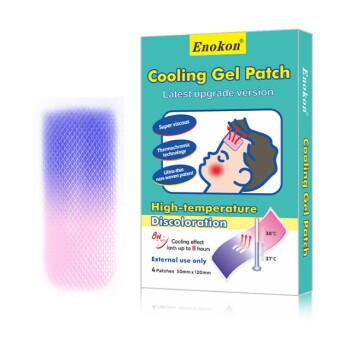Disposing of used or expired patches requires a specific safety protocol to prevent accidental exposure. The first and most important step is to fold the patch in half so the sticky, medicated sides press firmly together. The safest disposal method is to take it to a drug take-back program; if one is not available, place it in a durable, lidded container before putting it in the household trash.
The primary goal when disposing of a medicated patch is to prevent accidental exposure to its residual active ingredients. These leftovers can be extremely dangerous to children, pets, and the environment, meaning a used patch should never be treated like ordinary trash.

Why Special Disposal Is Critical
Understanding the risks associated with used patches clarifies why specific disposal methods are necessary. A patch that has been worn for its full duration is not "empty."
The Hidden Danger in Used Patches
Even after being worn for several days, a medicated patch can still contain a significant amount of its original active ingredient. This residual medication can be potent enough to cause serious harm if someone else is exposed to it.
Risks to Children and Pets
The primary danger is accidental exposure. A child finding a used patch in the trash might put it on their skin or in their mouth. A pet could chew on or swallow it. This can lead to a dangerous overdose.
Environmental Impact
Flushing patches down the toilet introduces potent pharmaceuticals into the water system. Wastewater treatment plants are not designed to filter out these complex chemicals, which can harm wildlife and contaminate water supplies.
The Hierarchy of Safe Disposal Methods
There is a clear order of preference for disposing of medicated patches, from the most to the least ideal.
The Gold Standard: Drug Take-Back Programs
The best and most responsible method is to use a community drug take-back program. These are often located at pharmacies, hospitals, or police stations and provide a secure way to dispose of unwanted medicines, ensuring they are destroyed safely.
When Take-Back Isn't an Option: Secure Home Disposal
If a take-back program is not readily available, the next best option is secure disposal in your household trash.
First, fold the patch in half with the sticky sides together. Then, place the folded patch in a durable container with a secure lid, such as an empty coffee can or plastic jug. This prevents it from being accidentally discovered or touched. Finally, place the sealed container in your household trash can.
The Outdated Advice: Flushing
Some older instructions recommended flushing certain powerful patches (like fentanyl or buprenorphine) to prevent them from being misused. However, due to environmental concerns, this advice is now outdated for most situations.
Flushing should only be considered a last resort and only if the official medication guide or your pharmacist explicitly instructs you to do so for that specific drug.
Common Pitfalls to Avoid
Simple mistakes can undermine the safety of your disposal process. Be mindful of these common errors.
Never Leave Patches in Open Trash
Do not simply toss a folded patch into an open wastebasket. The risk of a child or pet accessing it is too high. Always use a container and a trash can with a secure lid.
Don't Assume It's "Empty"
Never underestimate the amount of medication left in a used patch. Always handle it with the care you would use for a new one, and wash your hands after touching it.
Check Local and Medication-Specific Guidelines
Always refer to the disposal instructions that came with your specific medication. Some communities may also have their own rules or programs for pharmaceutical waste disposal.
Making the Right Choice for Your Situation
Your final decision should be guided by safety and accessibility.
- If your primary focus is maximum safety and environmental protection: Use an authorized drug take-back program as your default method.
- If a take-back program is not accessible: Securely seal the folded patch in a container before placing it in a lidded household trash can.
- If you are handling highly potent opioid patches: Verify the FDA guidelines or your pharmacist's instructions, as flushing may still be recommended as a last resort to prevent accidental exposure and diversion.
Properly disposing of your patches is a critical final step in using your medication safely and responsibly.
Summary Table:
| Disposal Method | Key Steps | Best For |
|---|---|---|
| Drug Take-Back Program | Return to pharmacy, hospital, or police drop-off | Maximum safety & environmental protection |
| Secure Home Disposal | Fold patch (sticky sides together), seal in lidded container, place in trash | When take-back is unavailable |
| Flushing (Last Resort) | Only if medication guide/pharmacist explicitly instructs | High-risk opioid patches to prevent misuse |
Ensure your transdermal patches are safe from production to disposal. As Enokon, a bulk manufacturer of reliable transdermal patches and pain plasters for healthcare/pharma distributors and brands, we prioritize safety at every stage. Benefit from our technical expertise for custom R&D and development to create patches that meet stringent safety and disposal guidelines.
Contact us today to discuss how we can support your product safety and compliance needs!
Visual Guide

Related Products
- Capsaicin Chili Medicated Pain Relief Patches
- Far Infrared Deep Heat Relief Patches Medicated Pain Relief Patches
- Far Infrared Heat Pain Relief Patches Transdermal Patches
- Heating Pain Relief Patches for Menstrual Cramps
- Menthol Gel Pain Relief Patch
People Also Ask
- Can the pain relief patch be used with other external analgesic products? A Critical Safety Guide
- What is the purpose of capsaicin patches? A Guide to Temporary Pain Relief
- How do you apply the Signal Relief patch to find the proper placement? A Step-by-Step Guide to Maximum Relief
- Are natural and herbal pain relief patches effective and safe? Discover the Benefits of Targeted Relief
- Are pain relief patches safe for sensitive skin? Your Guide to Safe Use & Skin Testing

















